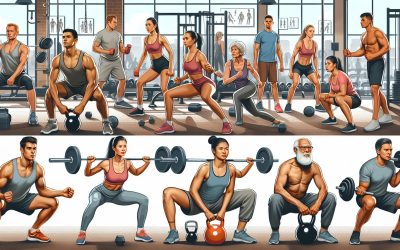Embarking on a fitness journey specifically targeting your shoulders can be a transformative experience, offering a blend of strength, flexibility, and resilience to your upper body. Knowing what to workout with shoulders is crucial to ensure balance and symmetry in your physique, and it all starts with a solid foundation. Incorporating a variety of exercises that target the different muscles of the shoulder girdle, including the deltoids, rotator cuff, and trapezius, is essential for comprehensive development.
When you begin, it’s important to focus on proper form to prevent injuries and to maximize the effectiveness of each workout. Engage in warm-up routines such as arm circles and shoulder stretches to prepare your muscles and joints for the workload ahead. Gradually increase the intensity and complexity of your exercises as your strength and mobility improve. Remember, consistency is key, and pairing your workouts with adequate rest and nutrition will amplify your results.
Ready to kickstart your wellness journey? Sign up for our content to receive exclusive tips and updates. Take the first step towards a healthier, happier you! Join Our Community Today!
Anatomy of the Shoulder: Understanding Muscle Groups
For those dedicated to enhancing their upper body strength, a fundamental understanding of the shoulder’s anatomy is key. The shoulder is a complex joint comprised of several crucial muscle groups, each responsible for a range of movements. The deltoid muscle, with its anterior, lateral, and posterior heads, is central to shoulder aesthetics and function, facilitating arm elevation and rotation. Beneath the deltoids, the rotator cuff—a group of four muscles—works synergistically to stabilize the shoulder joint during movement.
Incorporating the trapezius muscle into your routine is equally important; it extends from the neck to the mid-back, contributing to the shoulder blade’s movement. Additionally, the synergist muscles such as the serratus anterior and pectoralis minor play a pivotal role in the proper functioning of the shoulders. To optimize your workouts, exercises must be carefully selected to target these diverse muscle groups, ensuring a balanced and comprehensive approach to shoulder development.
Strengthening these muscles not only improves your physical appearance but also enhances performance and reduces the risk of injury. By engaging in a well-rounded shoulder routine, you provide your body with the foundation it needs for everyday activities and specialized movements alike.
Essential Shoulder Exercises for Strength and Mobility

Embarking on a journey to build strength and mobility in the shoulders necessitates the inclusion of essential exercises that target the complexity of the shoulder muscles. Initiating the routine with overhead presses works the entire deltoid area and can be performed using dumbbells, barbells, or kettlebells. Progressing to lateral raises, one can isolate the side deltoids, which are crucial for achieving that desired shoulder definition.
Front raises are next in line, primarily targeting the anterior deltoids, while reverse flyes hone in on the posterior deltoids, enhancing the back of the shoulder’s strength and appearance. To ensure the rotator cuff is not neglected, incorporate internal and external rotation exercises with resistance bands or light weights for optimal joint health.
Moreover, shrugs and upright rows will engage the trapezius muscles, contributing to the overall shoulder contour and upper back strength. Finally, incorporating dynamic movements like arm circles and shoulder stretches will improve mobility and reduce stiffness. A balanced mix of these exercises, performed with attention to form and appropriate resistance, will pave the way for robust shoulders that are both strong and supple.
Creating a Balanced Shoulder Workout Routine

A balanced shoulder workout routine is vital to ensure all aspects of the shoulder musculature are effectively engaged. To craft this balance, one must thoughtfully structure their workout to include a blend of exercises that target strength, endurance, and flexibility. Starting with compound movements such as the overhead press or push press can establish a foundation of strength for the entire shoulder girdle and upper body.
Following this, incorporating isolation exercises like lateral raises or front raises will further sculpt the deltoid muscles. These movements should be performed with moderate weights and higher repetitions to promote muscular endurance and definition. Rotator cuff exercises, often overlooked, are essential for shoulder stability and injury prevention. Integrating these with lightweight and high repetitions ensures the smaller muscles supporting the shoulder joint are also strengthened.
To round off the routine, stretching and mobility work should be included. This could involve dynamic stretches before the workout and static holds post-exercise to maintain a healthy range of motion. Ending the session with cooldown activities, like arm circles or cross-body shoulder stretches, will help in muscle recovery and prevent stiffness. By alternating between heavy and light days and allowing adequate rest, the shoulders can recover and grow, reducing the risk of overtraining or injury.
Advanced Techniques to Elevate Your Shoulder Training

For those looking to intensify their shoulder workouts, advanced techniques can be a game-changer. One such method is drop sets, where you perform a set to failure, then reduce the weight and continue to lift for more reps until failure. This approach pushes the muscles beyond their usual limits, promoting hypertrophy and endurance.
Supersets are another dynamic way to elevate shoulder training. By pairing two exercises back-to-back with no rest in between, such as a standing barbell press immediately followed by lateral raises, you can increase the intensity and volume of your workout, which is crucial for muscle growth.
Implementing eccentric training, which focuses on the lengthening phase of a lift, can also lead to significant strength gains. For example, taking three to four seconds to lower the dumbbells during a shoulder press will challenge the muscles differently than a traditional rep and can lead to improved muscle control and size.
Lastly, isometric holds, where you hold a weight in a fixed position for a period of time, can dramatically increase time under tension, a key factor for muscle building. Incorporating isometric holds at the peak contraction of an exercise, such as at the top of a dumbbell fly, can further fatigue the shoulder muscles and stimulate growth.
It’s important to remember that these advanced techniques should be used judiciously within a workout program. They are intense and can lead to overtraining if not balanced with adequate rest and recovery. As always, maintaining proper form is crucial to avoid injury and ensure the effectiveness of the workout.
Nourishing Your Body for Optimal Shoulder Health

Ready to kickstart your wellness journey? Proper nutrition plays a critical role in supporting shoulder health and overall muscle recovery. To ensure your shoulders are getting the nourishment they need, focus on a balanced diet rich in protein, essential for muscle repair and growth. Sources like lean meats, fish, legumes, and dairy provide the building blocks necessary for strengthening the shoulder muscles.
Omega-3 fatty acids, found in foods like salmon, flaxseeds, and walnuts, are also vital. These nutrients help reduce inflammation, which is crucial for recovery, especially after intense workouts that target the shoulder complex. Additionally, incorporating a variety of fruits and vegetables ensures a supply of vitamins and minerals that support muscle function and immune health.
Hydration cannot be overstated; drinking ample water is necessary for joint lubrication and muscle performance. Alongside water, electrolytes, particularly after a sweaty workout, support muscle contractions and prevent cramping.
For those looking to supplement their diet, glucosamine and chondroitin supplements are popular for joint health, potentially aiding in the cushioning and repair of shoulder joint tissues. However, it’s essential to consult with a healthcare provider before starting any new supplement regimen.
In summary, feeding your body with the right nutrients will significantly contribute to your shoulder training results and overall well-being. Balance, variety, and adequate hydration are the cornerstones of a diet that supports robust shoulder health.
Join Our Community Today! and take the first step towards a healthier, happier you! Receive exclusive tips and updates to help nurture your body, mind, and spirit on your transformative path to vibrant well-being.
Elizabeth Redd: I am a passionate advocate for Health and Healing, dedicated to empowering individuals to live their best lives.
As the founder and publisher of Health and Healing, I have established myself as a guiding force in the wellness industry.
I am committed to providing the latest research, holistic approaches, and inspiring stories to open new possibilities for your health and healing journey.
Learn more about Elizabeth and Join Us at Health and Healing. Also, check out My About Page.






0 Comments